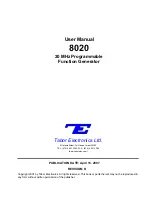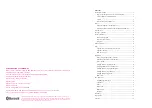
Additional Safety Rules for Petrol Products
Additional safety rules for Generators
• The generator is supplied with lifting handles on each side of the generator,
and when lifting, two operators should lift the generator together.
• The generator can also be fitted with wheels, and if these are fitted, the
generator can be moved with the additional front lifting handle by one
person.
• DO NOT OPERATE IN A HAZARDOUS LOCATION. SUCH AREAS INCLUDE
WHERE THERE IS A RISK OF EXPLOSION OF PETROL FUMES, LEAKING GAS
OR EXPLOSIVE DUST.
• DO NOT OPERATE IN A CONFINED AREA. EXHAUST GASES, SMOKE OR
FUMES COULD REACH DANGEROUS CONCENTRATIONS.
• THE OUTPUT OF THIS GENERATOR IS POTENTIALLY LETHAL. THE
GENERATOR SHOULD NOT BE CONNECTED TO A FIXED EALECTRICAL
INSTALLATION EXCEPT BY AN APPROPRIATELY LICENSED PERSON.
• Protect your generator. This generator is NOT WEATHERPROOF and should
not be exposed to direct sunlight, high ambient temperature and damp, wet
or high humidity conditions.
• Do not smoke while refuelling. This is potentially dangerous as it may ignite
the fuel and cause an explosion.
• Take care not to spill fuel. When refuelling the generator ensure that the
motor has been switched off. Prevent the spilling of fuel as this may also
ignite with the hot motor.
Never refuel whilst the engine running.
• Be careful where you store the generator. Store the generator in a dry area
away from inflammable liquids.
• Keep your distance. The generator emits exhaust fumes. As a safety
precaution do not stand close to the unit whilst it is in operation. Ensure
bystanders also keep their distance.
• Locate the generator for use in a convenient place so as to use the shortest
extension lead as possible, but still sufficiently away from the exhaust fumes.
• Ensure the generator has oil. Before commencing the generator, ensure that
the unit has been filled with SAE 10W-30 4 stroke oil.
• Any extension cable should be of heavy duty, 3 core and rated to 15A, and
suitable for outdoor applications.
• Never fill fuel tank indoors. Never fill fuel tank when engine is running or hot.
Do not smoke when filling fuel tank.
• NEVER REFUEL WHEN THE GENERATOR IS RUNNING. Switch the generator to
the off position prior to removing the fuel cap and refuelling.
• Not suitable for ethanol fuels.
• Engine speed has been factory set to provide safe operation. Tampering with
the engine speed adjustment could result in overheating of attachments and
could cause a fire. Never attempt to “speed-up” the engine to obtain more
performance. Both the output voltage and frequency will be thrown out of
standard by this practice, endangering attachments and the user.
• Do not parallel connect this generator with another generator, or any other
power supply.
You MUST unplug any load from the generator before starting and
stopping to prevent permanent damage to any appliances.
WARNING
• Persons who are fitted with a heart pacemaker, or similar medical conditions
should take care when using this device.
• Extension leads should be ordinary or heavy duty depending on the
application of appropriate current rating, and in any case not less than 1mm²
cross section of conductor for 10 A fittings, or 1.5mm² when 15 A fitting are
used, and incorporates an earthing conductor to ensure that there is no
voltage difference between the generating set and any equipment powered
by the generating set.
• The electrical continuity of the “earthing” core should be checked periodically
from pin to socket to ensure continued electrical safety.
• Some electrical appliances e.g. portable drills are marked or ‘double
insulated’, in which case there will not be an earthing conductor in its mains
lead (even though it may have a 3-pin plug).
Residual risks
Despite proper use, inconspicuous residual risks cannot be completely ruled out.
The following risks may arise due to the nature of the inverter:
• Injury to health from inhaling exhaust;
• Hearing loss if suitable ear protection is not worn.
6
7






































